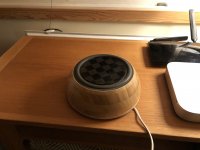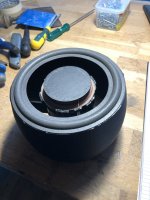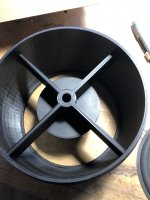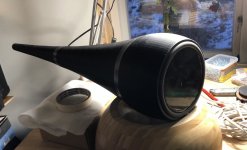Why would you be amazed, at why reducing the volume in the distortion area would reduce the distortion?This is amazing indeed!
I find it very interesting indeed that the DSP Eq reduces distortion to such a degree. Is this because of undamped panel resonances that are addressed or controlled by Eq?
I've been very very tempted to use a DSP-based EQ, with a pre-programmed curve embedded in an integrated chip in a pre-amp. And your results make me do a double-take and force me to consider this option very seriously.
Steve.
Most times, the distortions are due to bad quality exciters rather than the panel itself. Practically most 'exciters' are of dubious quality, even though their manufacturers state otherwise. 🙂 Maybe, its better to dismantle a good quality 3", 4" full range cone speaker to get at the motor.
When the exciter excites the physical structure it is attached to, it will induce a bending wave that travels along / in the physical media. This wave travels with the "sound speed" of that material - it is much harder than air and therefore travels much faster. As this wave propagates in the physical media, sound pressure is created thanks to the bending of the surface - the generated sound wave travels with the speed of air.The fact that "the speed of sound is much faster in a solid than it is in the air" has been brought up several times recently, and it got me thinking about what exactly is meant by the "speed of sound in a solid". And I realized only then the irony of our situation. And that irony is this: "the speed of sound in a solid" (as it is most commonly understood) is virtually irrelevant in the discussion of speakers .......
Eric
So two different speeds in play ;-)
//
And, the resistance of that material against that physical wave on its surface.When the exciter excites the physical structure it is attached to, it will induce a bending wave that travels along / in the physical media. This wave travels with the "sound speed" of that material - it is much harder than air and therefore travels much faster. As this wave propagates in the physical media, sound pressure is created thanks to the bending of the surface - the generated sound wave travels with the speed of air.
So two different speeds in play ;-)
//
Thanks very much SteveI went on a bit of a pub crawl yesterday in London, so am feeling a little delicate today.
But tonight I will force a can of beer down me tonight(hair of the dog) and make one of your domes.
I will attach it to the square fluted ,I think the square flute is called biplex ,not proplex?
I will measure the response and listen, and get back to you.
The domes I used for my thin 1mm panels was to prevent distortions in in the about 3k and 10k areas caused by the exciter problems mentioned in my posts.
I did not design them as a tweeter as such, but they do act as such depending on panel efficiency.
I look forward to your findings, whatever they may be.
Don't forget the damping ring midsection
And also try flipping on/off tests with masking tape
And listen for audible effects on vocals
Cheers
Eucy
Eucy.
Can you remember which page you posted information on how you created your dome?
Just to refresh my memory.
Steve.
Can you remember which page you posted information on how you created your dome?
Just to refresh my memory.
Steve.
as the panel radiates pistonically from the exciter area anyway , what difference will the dome make , apart from altering the frequencies and distortions in this area, and how will it destroy the DML benefits ?Yes it should increase the highs. But only on-axis. A dome will operate pistonically and destroy the DML benefits. You might as well put in a normal tweeter.
Steve.
Granted.as the panel radiates pistonically from the exciter area anyway , what difference will the dome make , apart from altering the frequencies and distortions in this area, and how will it destroy the DML benefits ?
Steve.
But then you may as well install a ring around the active area for similar benefit.
What exactly is the purpose of the dome itself? I mean technically. What do the measurements say?
Sure the 2nd harmonic reduces in lock-step with the amplitude. That is what one expects.Why would you be amazed, at why reducing the volume in the distortion area would reduce the distortion?
Steve.
But have a closer look at his 3rd, 4th... nth harmonics. There's a non-linear relationship between the EQ'd/UnEQ'd FR and the reduction of distortion at higher harmonics. What's going on there?
Last edited:
andre.
We have to remember that we are measuring a vibrating panel and a DML at that.
I do not know where the microphone was placed,
But if we moved the microphone a few inches the response and probably the distortion would change drastically.
Which is the correct response ?
Steve.
We have to remember that we are measuring a vibrating panel and a DML at that.
I do not know where the microphone was placed,
But if we moved the microphone a few inches the response and probably the distortion would change drastically.
Which is the correct response ?
Steve.
Exactly!andre.
We have to remember that we are measuring a vibrating panel and a DML at that.
I do not know where the microphone was placed,
But if we moved the microphone a few inches the response and probably the distortion would change drastically.
Which is the correct response ?
Steve.
It's a DML panel. That means there's no beaming. There's no coherent wave-front...
I have taken measurements of my panels outdoors, indoors, with the mic facing the panel floor, the ceiling, and the walls... Hardly any difference at all.
So I've given up measurements outside for anything over 150hz or so, and I measure everything indoors, with the speakers next to my computer desk, and the mic somewhere over my head. If I pick up something weird then I schlep the whole lot outdoors fwiw, and redo it all over again. Often to no avail.
Distortion measurements especially do not care where the mic is pointed. In any case, this applies to pistonics too: Distortion measurements are relative measurements; FFT's are performed on the relevant frequencies... A sine wave is a sine wave at any frequency. And if it changes to a square wave (or a saw-tooth or if it picks up "distortion") simply because of a different mic position or a bounce off a carpet or a curtain or a reflective surface then there's something else going on.
Steve ...Christian added it the database but here is a copyEucy.
Can you remember which page you posted information on how you created your dome?
Just to refresh my memory.
Steve.
Eucy
Attachments
In the end it's what your ears tell you that countGranted.
But then you may as well install a ring around the active area for similar benefit.
What exactly is the purpose of the dome itself? I mean technically. What do the measurements say?
Watching the videos here, #8,652, reminded me of this,

Actually why not an under suspended thin round flat membrane, as the DM panel, using anyway the 'bending waves' but with certain circular thin damping, with just one good quality transducer at the centre? A paper tube glued on to the coil former/bobbin of the transducer could transfer the energy to the membrane, while keeping the transducer away from the membrane. Waves always travel away radially, as in "pebble in the pond." The open end of the membrane won't block the waves from dissipating.
Considering the fact that waves travel away radially, a rectangular membrane is somewhat abnormal.
Actually why not an under suspended thin round flat membrane, as the DM panel, using anyway the 'bending waves' but with certain circular thin damping, with just one good quality transducer at the centre? A paper tube glued on to the coil former/bobbin of the transducer could transfer the energy to the membrane, while keeping the transducer away from the membrane. Waves always travel away radially, as in "pebble in the pond." The open end of the membrane won't block the waves from dissipating.
Considering the fact that waves travel away radially, a rectangular membrane is somewhat abnormal.
Last edited:
Thank you Dave. Is it possible you focus on let say -10 to 30ms to show the decay of the resonances. Sorry not having specifying it before.T
The distortion did improve some after EQ in the 1kHz area (see attached). The exciter is mounted essentially in the center of the panel. Attached are the before and after EQ REW spectrograms.
Thanks, Dave
Christian
Thanks Eucy and Christian.Steve ...Christian added it the database but here is a copy
Eucy
I have this dome I made some time ago from a coffee container.
It is thinner and lighter than the can I think, will this do, or shall I use the can ?
I used it as a whizzer, but it was not as good as using the whole container.
What panel material do you want me to attach the dome to ?
Steve.
Attachments
Hi Steve...I think for consistency you should first try the can... Shape may have an influence as well... It's a very flat domeThanks Eucy and Christian.
I have this dome I made some time ago from a coffee container.
It is thinner and lighter than the can I think, will this do, or shall I use the can ?
I used it as a whizzer, but it was not as good as using the whole container.
What panel material do you want me to attach the dome to ?
Steve.
It is important to dress the mating surface carefully, and be very sparing with damping.. In fact you could try it without damping to begin with
I've used it on 3mm Poplar ply and 5mm corflute. It made a difference in both cases... You could try both depending on what you have available
Cheers
Eucy
Our ear canal is round, the exciter we use is round too. Waves travel away radially, so it should be normal to use a round membrane for the DM panel and place the round exciter at the centre. Even the dome made by Eucyblues99 is round. It doesn't seem appropriate to ask the one round exciter to run a rectangular membrane well. Sure, practically any panel/membrane touched by the exciter would sing. But, would it do that equally well as a round one? All cone speakers are round, or at least oval.
But, if we are adamant on using a rectangular panel/membrane, maybe then place two exciters in the middle line of the longer side equidistance from the edges and the centre of mass? As here, #7,321. There I was experimenting with two channels, but now it hit me why not one rectangular panel with two equal exciters placed that way. Sometimes I think, why we are running after failed NXT ideas. The company that bought the rights for NXT patents and licences doesn't actually make NXT speakers.
But, if we are adamant on using a rectangular panel/membrane, maybe then place two exciters in the middle line of the longer side equidistance from the edges and the centre of mass? As here, #7,321. There I was experimenting with two channels, but now it hit me why not one rectangular panel with two equal exciters placed that way. Sometimes I think, why we are running after failed NXT ideas. The company that bought the rights for NXT patents and licences doesn't actually make NXT speakers.
I have made some prototypes along these lines i.e. BMR. I have used a regular 7 inch foam surround in both cases. The diaphragm is 2mm balsa an CF. The black one is 3D printed as you can see. It uses the tectonic driver as I have used in previous speaker. The box is a reversed exponential horn , similar to B&W nautilus.Watching the videos here, #8,652, reminded me of this,
View attachment 1131638
Actually why not an under suspended thin round flat membrane, as the DM panel, using anyway the 'bending waves' but with certain circular thin damping, with just one good quality transducer at the centre? A paper tube glued on to the coil former/bobbin of the transducer could transfer the energy to the membrane, while keeping the transducer away from the membrane. Waves always travel away radially, as in "pebble in the pond." The open end of the membrane won't block the waves from dissipating.
Considering the fact that waves travel away radially, a rectangular membrane is somewhat abnormal.
The other is using a sallads bowl from ikea🤪 and an exciter from dayton (It is closed box).




- Home
- Loudspeakers
- Full Range
- A Study of DMLs as a Full Range Speaker
